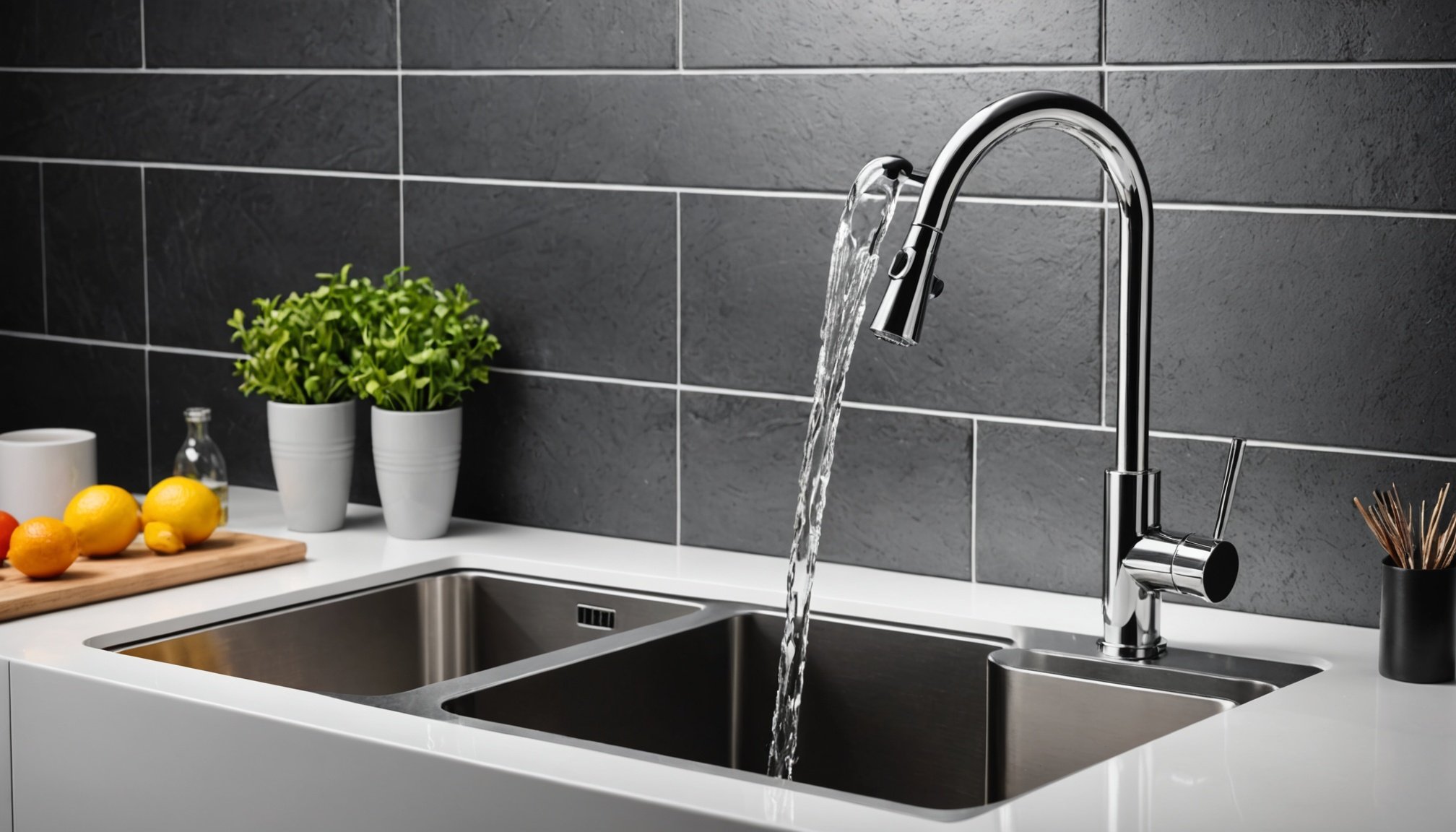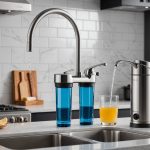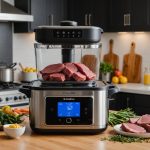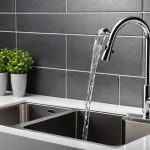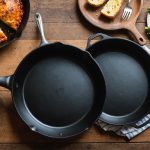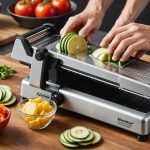Understanding Kitchen Taps
In the UK, kitchen taps are more than just a means to pour water. They come in various types, each offering unique functionalities and features to suit different needs. The two-handle tap, for instance, offers separate controls for hot and cold water, providing precise temperature adjustment. The single-handle tap, on the other hand, allows easy operation with one hand, making it a popular choice for busy kitchens.
Types of Kitchen Taps
Mixer taps are among the most common, allowing hot and cold water to combine before leaving the spout, offering a streamlined look and efficient use of space. Pull-out spray taps come with a retractable head, ideal for washing vegetables or cleaning the sink thoroughly.
This might interest you : Elevate your uk kitchen window to a verdant herb oasis: your ultimate step-by-step guide
Tap Features and Aesthetics
When selecting kitchen taps, consider both aesthetics and ergonomics. Modern designs can elevate your kitchen’s appearance, while ergonomically designed taps can enhance comfort and ease of use. Choose features like swivel spouts for flexibility and water-efficient models to reduce consumption without sacrificing performance.
With such a wide variety of kitchen taps, assessing your specific needs, space, and style preferences can help you make an informed choice, ensuring functionality and style harmonize perfectly in your kitchen space.
This might interest you : The essential handbook for selecting the ideal cast iron skillet for your uk culinary needs
Water Conservation Features
Understanding water conservation features in household fixtures like taps can meaningfully reduce consumption. Aerators are small devices attached to tap ends, designed to mix air into the water stream. This not only softens the flow but also cuts down on water usage by reducing the amount passing through. They maintain pressure while minimising wastage, a practical method that supports sustainable living.
Flow restrictors further enhance water conservation by limiting the flow rate of water. Installed within kitchen taps, these devices effectively manage how much water is expelled without noticeable pressure changes. Apart from conserving resources, they also lower utility bills, providing an economic advantage.
Additional technologies, such as adjustable spray settings and sensor-activated taps, contribute significantly to water savings. Adjustable settings allow users to select the most appropriate flow for their needs, while sensor-based taps only run when necessary, avoiding excess use. These innovations represent a comprehensive approach to reducing water wastage, crucial in both protecting the environment and ensuring resources for future generations. Together, aerators, flow restrictors, and other advanced fixtures form a holistic strategy for efficient water management in the home.
Choosing Sustainable Kitchen Taps
Selecting sustainable kitchen taps involves considering both the materials used and the manufacturing processes. It is crucial to identify eco-friendly options, which often utilise materials like stainless steel or brass, known for their durability and recyclability. Additionally, taps finished with non-toxic coatings add to the eco-friendliness.
Emphasising on certifications and standards ensures the taps are genuinely sustainable. Certifications such as LEED, BREEAM, or the WELL Building Standard validate eco-friendly claims by assessing the environmental impact of products. These certifications also confirm that the production process adheres to sustainability norms, reducing overall carbon footprints.
When deciding on sustainable kitchen taps, it’s wise to consider brands that are reputed for their environmental consciousness. Brands like Grohe and Kohler, for instance, have established themselves as leaders in the market, offering products that align with eco-friendly standards. These companies focus on innovative designs that conserve water and energy, without compromising on style or functionality.
By carefully evaluating these factors, you can make a well-informed decision that benefits both your kitchen and the planet. Sustainable choices not only contribute to a healthier environment but also often result in long-lasting, efficient products.
Brand and Model Comparisons
Navigating the myriad of kitchen tap brands in the UK market can be daunting. Understanding how these brands and their models stack up against each other is essential for making informed choices. This section offers a comparative analysis of top brands to ease this process.
Many users consider performance reviews crucial, as they highlight each model’s practical benefits and potential drawbacks. Across varying performance levels, water-saving features stand out as a significant aspect influencing purchase decisions. Modern taps from renowned brands incorporate advanced water-saving technologies that balance pressure and flow efficiently.
Exploring model comparisons, it’s evident some brands offer superior durability and innovative designs. For instance, models from Grohe and Franke often receive praise for long-lasting build quality and sleek appearances. Other brands, like Bristan, frequently come up in consumer discussions for their user-friendly installation processes.
Ultimately, user reviews and ratings serve as a reliable barometer for potential buyers. They provide insights from real-world experiences, revealing how these taps perform over time. Identifying common praise or complaints in these reviews can guide buyers in choosing taps that meet their specific needs and preferences.
Installation and Maintenance Advice
Successfully installing and maintaining a kitchen tap can seem daunting, but with the right plumbing knowledge and maintenance tips, it becomes straightforward and manageable.
Step-by-step Guide to Installing a Kitchen Tap
To begin, ensure you have all necessary tools: an adjustable wrench, basin wrench, and plumbing tape. Start by turning off the water supply and disconnect the old tap. Next, position the new tap above the sink hole. From beneath, secure it using the mounting hardware provided. Connect the water supply lines, wrapping the threads with plumbing tape to prevent leaks. Finally, turn the water supply back on and check for leaks.
Common Maintenance Practices
Maintaining a tap involves regular cleaning and inspection. Clean the tap installation and surrounding areas weekly to prevent build-up of limescale and grime. Maintenance tips include regularly checking for leaks at connections and ensuring the aerator is free from debris to maintain steady water flow.
Troubleshooting Issues
Common problems include low water pressure and leaks. For low pressure, clean the aerator or check for blockages in pipes. For leaks, inspect all joints and seals, tightening them as necessary. Regular maintenance can drastically prolong a tap’s lifespan and prevent recurrent issues.
Cost-saving Benefits of Efficient Kitchen Taps
Investing in efficient kitchen taps contributes significantly to water bill savings by reducing water usage. Modern taps, equipped with advanced flow regulators and aerators, limit water flow without compromising performance. This can lead to substantial savings on your water bill over time. By trimming water usage, households can realise noticeable cost-saving.
Moreover, the long-term financial benefits of investing in high-quality kitchen taps are notable. While the initial investment might seem steep compared to standard taps, the return on investment can be impressive. Efficient taps not only cut down on utility bills but also require less frequent replacements due to their durability, further enhancing savings.
When comparing the upfront costs with long-term efficiencies, it becomes apparent that the initial outlay is often justified. Although quality kitchen taps may have a higher purchase price, their robust design and efficient water usage lead to marked savings which quickly offset the initial expense. Thus, opting for efficient kitchen taps is a financially sound decision, ensuring water conservation and cost-effectiveness in the long run.

